Sarah Forster reviews current releases Harriet and the eye of the Bird, Bonjour Lucy Bee and The Invincibles: Power Up! She also reviews a final manuscript for Tūī Street Heroes, thanks to Wildling Books. This will release in September.
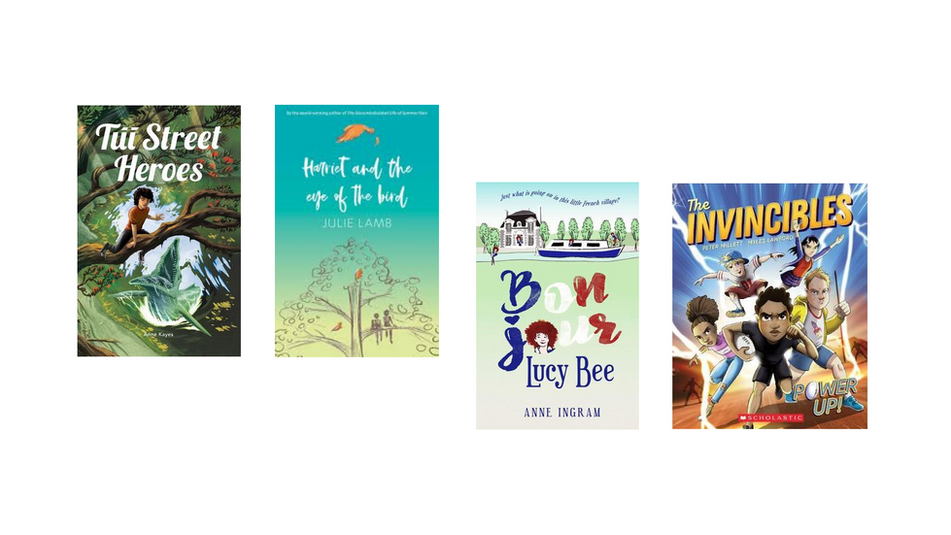
The Invincibles: Power Up! by Peter Millett, illustrated by Myles Lawford (Scholastic NZ)
I can hear the school librarians from here. Finally – a junior fiction series about rugby, written by a New Zealander. Instead of the All Blacks, we have the All Greats, and instead of the Black Ferns, we have the Black Storms, and both are the best in the world.
Our protagonists are Scotty, Tana, Muzza, Andrea and Zinnia – not quite enough for a rugby team, but just the right number to structure a book with them at their centre. They meet at tryouts for Team Two at a high school in Arakino – Zinnia is trying out, Andrea is just watching until all of a sudden there is a huge explosion, and the players are knocked off their feet, twice, turning a ghostly neon blue. ‘[Tana] quickly jumped up. The dark clouds were moving in swirling patterns, casting huge, spooky shadows across the field.’
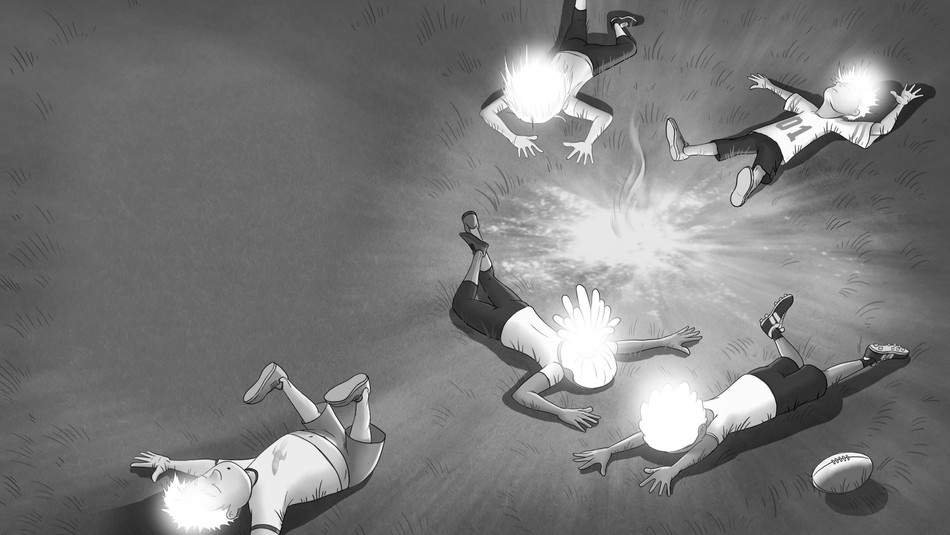
Hilariously, it isn’t just the five that get superpowers – there are also sheep with superpowers, because they were on a field nearby. ‘Everyone turned, just in time to see sheep fly up and over the goalposts.’ We discover, alongside the protagonists that Muzza has a super-boot and x-ray vision; Andrea has super-vision; Zinnia has super-speed; Scotty has super-breath (and farts); and Tana can manipulate electricity. All of them figure out they can fly. Of course, as with all powers, they have to work out how to activate them – when they first emerged, they remained for 90 minutes: the length of a footy game. But how do they get them back?
The narrative takes in all of the kids throughout, which means we don’t get a massive sense of who they are and what they are all about. The girls are initially depicted as a bit offhand because they don’t 100% want to play with the boys, Scotty is the joker, Tana the leader… but beyond that, there isn’t a lot in the way of relatable personality traits or emotions shown. This is true of some action hero films as well, but I’d like to see more inner life in the kids in future books within the series. It is a diverse cast though, which is appreciated – it would have been very easy to stick with a boys-only rugby team.
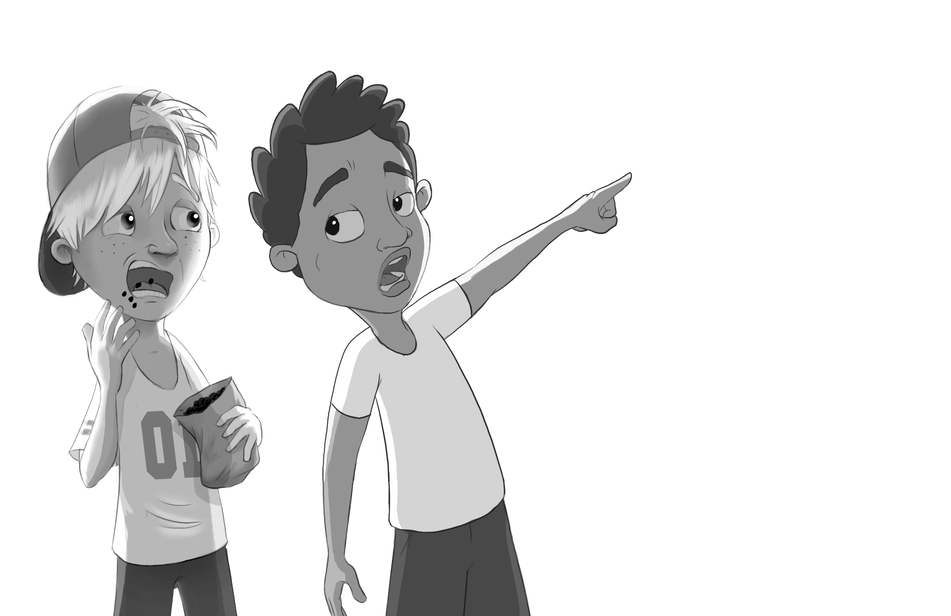
The arch-villain is Tricky Ricky. Tricky Ricky is out to get the All Greats because in his final game against them, his pants fell down and he tripped over and lost the ball. As a result, he’s made his living advertising toilet seats – which has somehow made him a billionaire. He wants revenge, because the All Greats get to sell cool things like cars and planes. He says to his assistant: ‘And how are my top-secret A-Bots doing? Are they 100% prepared for their top-secret mission?’
And this becomes the mission of Team Two: renamed The Invincibles – they happen to hear on the police radio that the All Greats have been hijacked, and they decide they are the ones to get them back.
Young readers will enjoy this book for the humour, the cool tricks the heroes can do and the great heroic adventure the team go on to save the All Greats. Millett may trick kids into enjoying his books with his storytelling skills and humour writing, but he also includes little science lessons throughout. When the kids are worried about going out against the robots ‘because they could be made of titanium’, Zinnia coolly notes (after an explanation from Tana), ‘The bigger they are, the harder they fall’.
Young readers will enjoy this book for the humour, the cool tricks the heroes can do and the great heroic adventure the team go on to save the All Greats.
With some pretty amazing illustrations by Myles Lawford, The Invincibles: Power Up! is perfect for readers who have just started reading alone, and who may usually prefer sports and Marvel movies to reading.
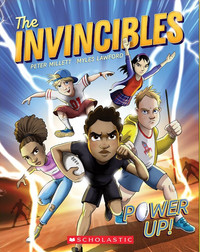
the invincibles: Power Up!
By Peter Millet
Illustrated by Myles Lawford
Scholastic NZ
RRP $15.00
Bonjour Lucy Bee, by Anne Ingram (OneTree House)
I can already think of a few French-NZ families I’ll be recommending this family-oriented story to. Lucy Bee has gone to France for a family reunion with her mum’s French family. It is meant to be Gamma’s final trip to see her family, but she has sadly had a stroke, and can’t travel – and Nanna Kate has to look after her.
Lucy’s first impression of France is mixed – they come across a group of refugees on the side of the road, and her cousin Celeste is unkind about them. Lucy falls asleep after arriving at their aunt and uncle’s house, then dreams of them, and tells her mother ‘Refugees are people too! And five boys aren’t exactly a flood!’
Author Anne Ingram captures well the bewilderment we all feel when we find ourselves in an unfamiliar place. And she wastes no time in plunging Lucy into an adventure, with one of the family dogs, Beau. Beau finds one of the young refugee boys in the bushes, with a broken foot. He is about Lucy’s age, and his name is Qasim. His entire family was murdered several years earlier in Afghanistan, and after a long, difficult journey, he is in France illegally. Lucy stashes him in a house she knows is abandoned, and leaves him for the night, choosing to tell one other member of the family – Jean-Luc.
Author Anne Ingram captures well the bewilderment we all feel when we find ourselves in an unfamiliar place.
Not long after this happens, her mum falls some way down some steep stairs on the way down a tower and breaks her ankle, meaning she and Lucy have to move away from their base of Tante Elise and Oncle Aubrey’s guest house, moving to Tante Elise’s parents place a little way out from town. Luckily, Jean-Luc is in control of the Qasim situation, though this is all to change.
Meanwhile, there is a deeper mystery afoot – there are thieves travelling the same area of France as Lucy and her family, robbing chateaux. And what is up with the antiques dealer Raoul and her cousin Jean-Luc, and Guyot? The plot gets a little complex here as the family goes onto a canal boat and moves around and I did a fair bit of flipping back and forth to keep of track of the range of characters, and whether they were heroes or villains, but it ultimately resolves.
Ingram has skilfully presented the emotions of a morally engaged young girl confronted with unfamiliar cultural values in this book, and that was enough: the subplot of a thief and drug dealers was a distraction from what is a very well-written narrative focusing on the ability of children to see a moral surety where adults so often cannot.
Ingram has skilfully presented the emotions of a morally engaged young girl confronted with unfamiliar cultural values in this book…
It was also wonderful to see the many French phrases interwoven in the narrative as Lucy learns more of the language that is her heritage. I enjoyed Lucy’s observations on how her family is different and similar to her – where Lucy has wild curly hair, most of the family has nice smooth hair, except for great-aunt Adele. When she comes to the family reunion ‘Her eyes went straight to me and she came over and took both my hands in hers. “Chère Lucy,’ she said. ‘Nous sommes si semblables”… She put a hand to my hair, then touched her own corkscrew curls. They were cut short and grey, and if anything, frizzier than mine.’
I would recommend this book to anyone who enjoys well-written family stories, who doesn’t mind a side of high-stakes canal boating. The child’s view of the rights of a refugee to sanctuary are very well elucidated, and I think deep-thinking pre-teens in particular will enjoy it. Recommended for ages 9+.
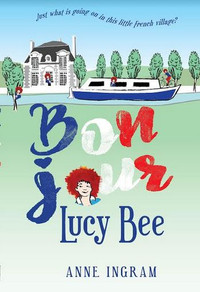
Harriet and the Eye of the Bird, by Julie Lamb (Ahoy!)
I absolutely loved The Discombobulated Life of Summer Rain, and I’ve been looking forward to this book for about 15 months now, since editor Anna Golden told me she was working on it for Mākaro Press. It has now been published through Ahoy!, The Cuba Press’s new children’s fiction imprint, and it was worth the wait.
As in her previous book, Lamb has told a story of big emotions, starting with a dramatic episode where Harriet’s dad comes home after being out drinking all night. Harriet’s mum starts yelling, and he leaves… and doesn’t come back. Harriet then hears a blackbird slam against the window and goes out to find the bird, who needs to be buried. ‘Grandad Jackson once told me creatures loved by humans move on to a higher place when they die. So I blew Blackbird a kiss to help him on his way (because being in a higher place sounded nice for a bird) and filled in the hole.’
As in her previous book, Lamb has told a story of big emotions, starting with a dramatic episode where Harriet’s dad comes home after being out drinking all night.
After their dad leaves, they can’t afford the rent for the place they are in, so Harriet, her mum, and her sister move to be closer to her mum’s mother, and Grandad Jackson – their dad’s dad – so their mum can get a job. Harriet is 12 and Claire, her older sister, is 14. ‘I stuffed a double-whammy biscuit into my mouth to stop the double-whammy pain. I knew I would never be happy again…’
Harriet has to move schools, which she isn’t happy about. The only thing that helps her manage her strong emotions is eating, which eventually leads to bullying. While she does make a friend, another new girl called Alice, she sees her as a ‘spare’ friend – the type of friend you make when nobody else will let you be their friend.
As I noted above, bullying is a theme in the book – Harriet wants to be friends with Genevieve, but Dana is possessive of her – and Dana is one nasty piece of work. Lamb has a great understanding of the complexity of the pre-teen female relationships, and all elements of the story rang true.
As well as being the ‘new girl’, Harriet puts on weight – and as such, she is given the nickname ‘Fatty’. I was a bit sensitive as to how this would play out, but while mum puts more healthy options in her lunchbox, there is no overt fat-shaming in the story, only practical aspects – having to buy bigger clothes and so on. I’d still be cautious of a trigger in this, for kids who have been teased in this way in the past, and who have experienced rapid weight gain for any reason at all.
Another theme of the book is a strong relationship with a grandfather – this is something the book has in common with Summer Rain. Harriet grows close with her grandfather as she spends more time with him, learning that his wife abandoned him with her dad when he was little, and he had a carer called Aroha, who lived in a house-van. ‘I wanted to talk to Grandad about Dad, but didn’t know how to start…In the end we just sat there with our flip-floppy-ploppy hearts showing all over our faces together.’
‘I wanted to talk to Grandad about Dad, but didn’t know how to start…In the end we just sat there with our flip-floppy-ploppy hearts showing all over our faces together.’
As well as drawing realistic pre-teen characters, complete with flaws, Lamb is a wonderful, lyrical writer when she lets herself go – there is a scene where Harriet imagines herself as a bird, which is absolutely stunning. ‘How could I tell her that I sometimes dreamed I was a bird? That I knew what it felt like to tap free from an egg, and swallow mushy worms, that I had experienced the exhilaration of launching from a tree and bouncing on air currents – diving and swooping…’
Harriet and Alice’s friendship becomes more true as the story wore on, and Harriet realises the value of a kind and loyal friend. But of course, there is a twist: the bully, one way or another, gets their comeuppance.
I highly recommend this book for kids going through a phase of change, perhaps when moving to an intermediate school, or changing schools altogether. Do keep the bullying themes in mind though – if your young person has been bullied for their weight, be aware this is a theme in this book, no matter how sensitively it is handled.
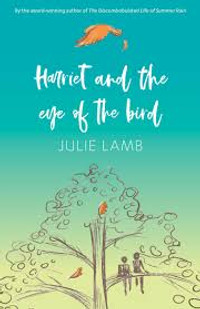
Tūī Street Heroes, by Anne Kayes (this title will not be released until September 2019)
A couple of years ago I had the pleasure of reading Tūī Street Tales by Anne Kayes, which had won the Tom Fitzgibbon Award in 2016 – so I was delighted to learn there was a sequel. Tūī Street Heroes carries on the stories of the original characters of the tales, while introducing several new characters, including an Irish student teacher, Ms Brennan, who sets them an assignment to write three heroes journey tales over the term.
As with the stories in Tūī Street Tales, the adventures that occur are influenced by fairy tales, and we begin with a story up the beanstalk – Jack’s beanstalk. Ella’s kitten Ngeru has gone adventuring, and she can hear her miaowing from a long way away. Each of the children has to pluck up their courage when deciding to follow Ngeru up, up, up into the clouds.
I enjoyed the realistic relationships that the children have with one another, and their recognition of each other’s strengths and weaknesses, and their distinct personalities. As Ella, Lucy, Jack and Tim climb the tree, Ella recognises that Jack and Tim are keeping a secret: ‘She felt a pulse of annoyance at them’. She also recognises that Tim gets worried easily. She recognises that her feelings of loss over her kitten are related to how she feels about her mum dying. ‘”He’s a stupid cat, Mum,” she whispered, hugging the trunk. For a few seconds, she let herself imagine that she was hugging her mother, then she pulled away.’
I enjoyed the realistic relationships that the children have with one another, and their recognition of each other’s strengths and weaknesses, and their distinct personalities.
Kayes is equally talented at writing plot and dialogue as she is at creating characters. While I found the set-up for the heroes journey stories a bit on the nose, the way in which they eventuate is not at all forced, and the directions in which the stories go are unpredictable.
The first story is the only one relating to a fairy tale familiar to me, and even then, when the friends reach the top of the beanstalk, they find the giants in the grip of the ‘Fee-fies’ – a giants-for-giants political party that has blocked all known sky-hole entrances into Sky Country from the human world below. George, our friendly giant from Tūī Street Tales, has Ngeru – but the friends have some trouble trying to escape the Fee-fies, throwing some curves into the story of their return home, involving a great army of ruru, karearea, kahu, tūī and korimako, led by the miromiro.
As we reach our second story, Mr Naufahu’s granddaughter Pesi joins the group of friends. She and her family are Tongan, so her legends are based in the Tongan tradition. It’s this Tongan tradition, along with Māori mythology, that inspires the next story, which brings the witch Lula (the evil stepmother of twins Gemma and Harry) into their orbit again, as well as a startling array of extinct New Zealand creatures, including a taniwhasaurus. I particularly liked how Pesi took on the role of an external observer, from being new to the group and a bit unsure of herself, trying to work everyone out, then growing in familiarity and friendship as the tale carried on and took them into even more danger.
Pesi took on the role of an external observer, from being new to the group and a bit unsure of herself, trying to work everyone out, then growing in familiarity and friendship…
The third story is Louie’s tale – in the previous book Louie wasn’t often allowed out, as his mum was worried about what would happen to him. Now, he is allowed to work in the garden at Mr W’s, where he finds a monolith, Menhir, which intrigues his friends. This tale involves a book, pixies, alternative realities and more giants. Louie is relatable in his fear of change, and his determination to wreak it in his tale as well as his own life.
The tales aren’t linked, but in each set-up for the story, the friends discover similarities of mythologies across different traditions – particularly with respect to Tongan, Māori and European mythologies. This encourages the reader to think harder about perspectives on stories and where they may have originated, as well as connecting common features of cultural tradition. The way in which every tale is set within Awatiu (the fictional town in which the kids live) also heightens our view of how our own surrounds are worthy of telling tales about.
I highly recommend this collection for kids aged 8 to 12, and think Kayes has written a worthy follow-up to Tūī Street Tales. Next, I hope to see these characters ditch the writing prompts run free over the full course of a new novel.
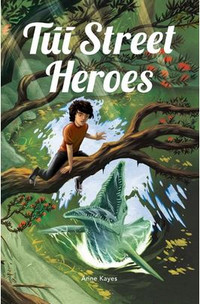

Sarah Forster has worked in the New Zealand book industry for 15 years, in roles promoting Aotearoa’s best authors and books. She has a Diploma in Publishing from Whitireia Polytechnic, and a BA (Hons) in History and Philosophy from the University of Otago. She was born in Winton, grew up in Westport, and lives in Wellington. She was a judge of the New Zealand Book Awards for Children and Young Adults in 2017. Her day job is as a Senior Communications Advisor—Content for Te Herenga Waka—Victoria University of Wellington.



